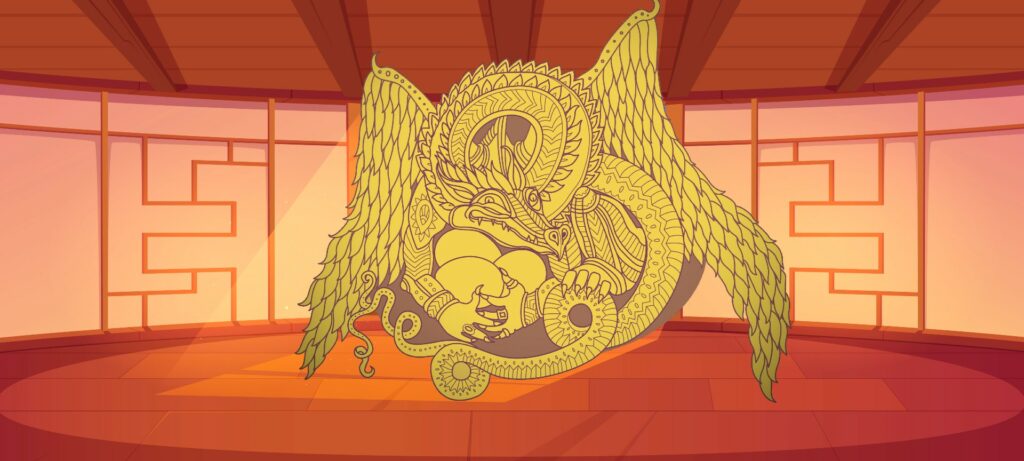
Welcome to the Dragon’s Nest!
This is the most sacred part of the Dragon Temple. Everything in this room is designed to call out to the Wyvern Spirts and invite them to come and participate in the training of new Dragon nestlings. Outsiders are forbidden from ever entering, and even villagers are only allowed in on special occasions such as during the Cùxiāo jié festival.
The large room is designed with ascending balconies that signify the accession of a a Xué from the selfishness of childhood to the unification of souls, required for four separate persons to become and act as a single dragon. Every four years, the Dragon nestlings ‘ascend’ upward to the next balcony, and that much closer to their ultimate purpose represented by a large series of statues on the ceiling of the Nest.
The Ceiling of The Nest
Four stories above the central floor, suspended on the ceiling of every Dragon temple there is a large statue depicting four dragons surrounding a central lotus flower. The four dragons represent each member of a fully realized Dragon Xué, acting in perfect unison to fulfill their mission as a single Dragon soul.
It is worth noting that this statue is intentionally hung above even the top balcony. Signifying that no Xué can ever fully ascend toward perfection. Even at the age of 24 when they leave the temple, and begin their service to the order, they will always remain just a little below the ideal, and must continue to strive toward a lifelong pursuit of increasing unity and perfection.
The Balconies of The Nest
The Nest is surrounded by four inner balconies. Each representing one quarter of a Nestling’s journey toward perfection. They spend four years working and training on each of these levels. The bottom most level is blue, and is represented by a flower known as a Blue Engrow. The second level is orange and is represent by an orange poppy. The third level is green, and is represented by a Green Dahlia. The fourth level is white, and is represented by a white lily. White is used as the final color due to its symbolism of purity and perfection. Reminding Nestlings that this is what they are striving to achieve as they continue their ascension upward toward the Lotus Flower statue.
Protecting The Nest
It is the sacred responsibility of all Dragons, both living and dead, to protect the Nest. The symbol of a dragon sitting on a nest jealously protecting the nestlings, is used to remind Dragon nestlings of all those who are supporting them as they travel through their 16 year journey of ascension. Dragons believe that while they are in the nest, they are constantly surrounded by countless Wyvern Spirits of the Dragons who have lived before them, and that they themselves will someday have the same obligation both while living and also after the deaths to help defend the Nest and its precious Nestling harvest.
Primary Activities In The Nest
Given the sacred nature of the Nest, nestlings do not enter the space without a reason to do so. This means that they typically opt to walk around the outer hallways of the Temple rather than take shortcuts through the Nest, so that they do not disrupt any Wyvern Spirits that may be carrying on important business. Nestlings believe that if they listen quietly at the doors of the Nest, they can sometimes even hear these Wyvern Spirits as they move through the space.
It is not so much that it is forbidden to enter the Nest, as that it is simply considered rude to interrupt the work going on in there by these Wyvern Spirits.
Of course during times when the Nest is being used by the living, these expectations change, and the living may enter and leave without causing offense. Such as during the Cùxiāo jié Festival when the entire village gathers into the Dragon’s Nest to observe the Lóng Tiǎozhàn. Other times when it is not considered rude for the living to trespass in the Nest are during a Cháo zhàn when two Xué are pitted against one another in a battle designed to test their skills.
The space is also used to carry out public trials. During these trials, the accused is brought to the central floor. The Dǎoshī stands directly beneath the Lotus Flower, which is the most sacred part of the Nest. It is considered to be the ‘Place of Wisdom’. Where the spiritual energy of the Temple is strongest, and where the Dǎoshī can tap into the great wisdom of the many Dragons who have lived before. From this place of wisdom, the Dǎoshī can act with authority and with the fire of truth.
The accused is placed before them, and the Dǎoshī’s rulings are sealed with the power of the Wyvern Spirits. Trials are a rare time when villagers are often invited as witnesses so as to ensure fairness and integrity.